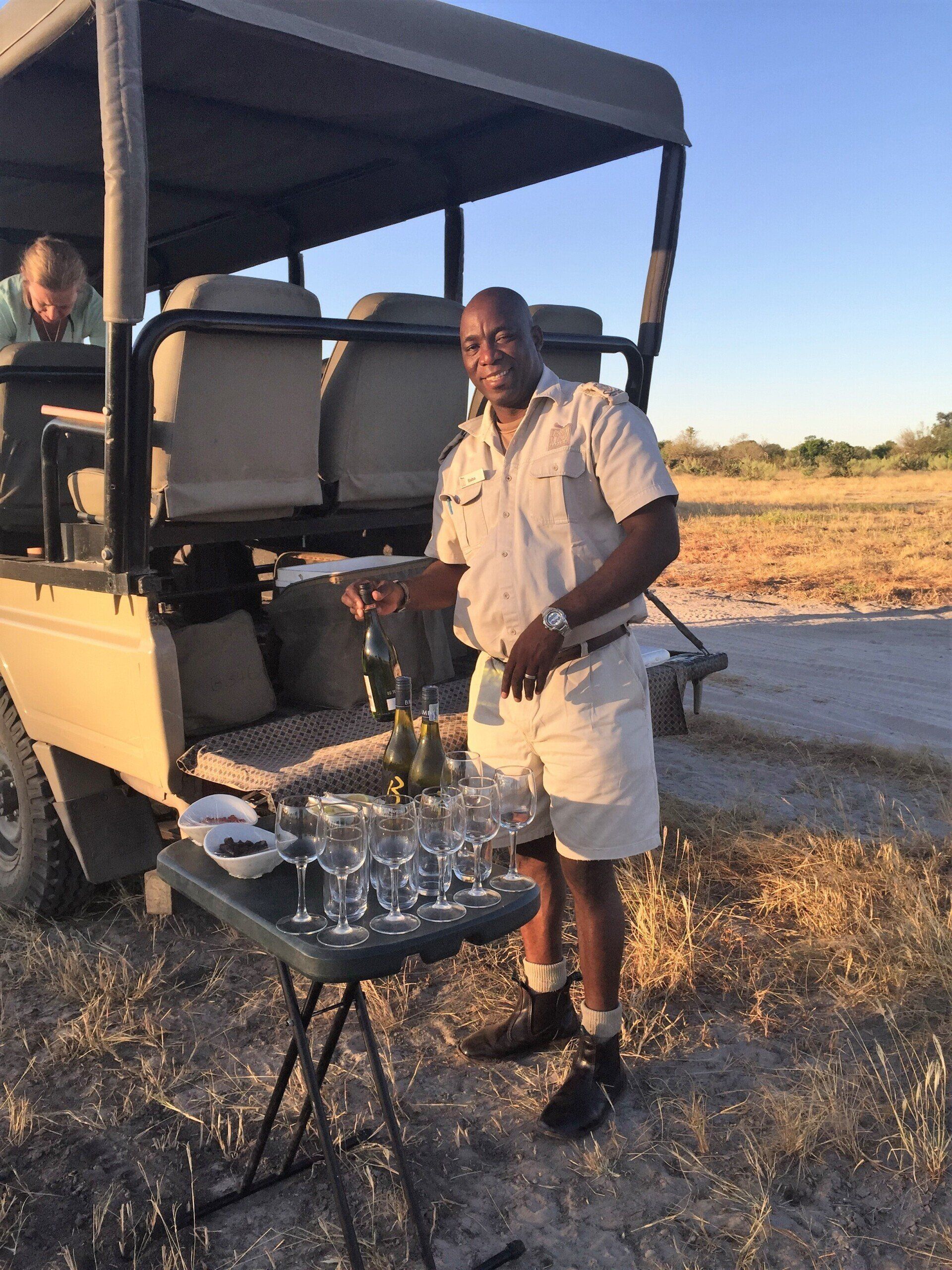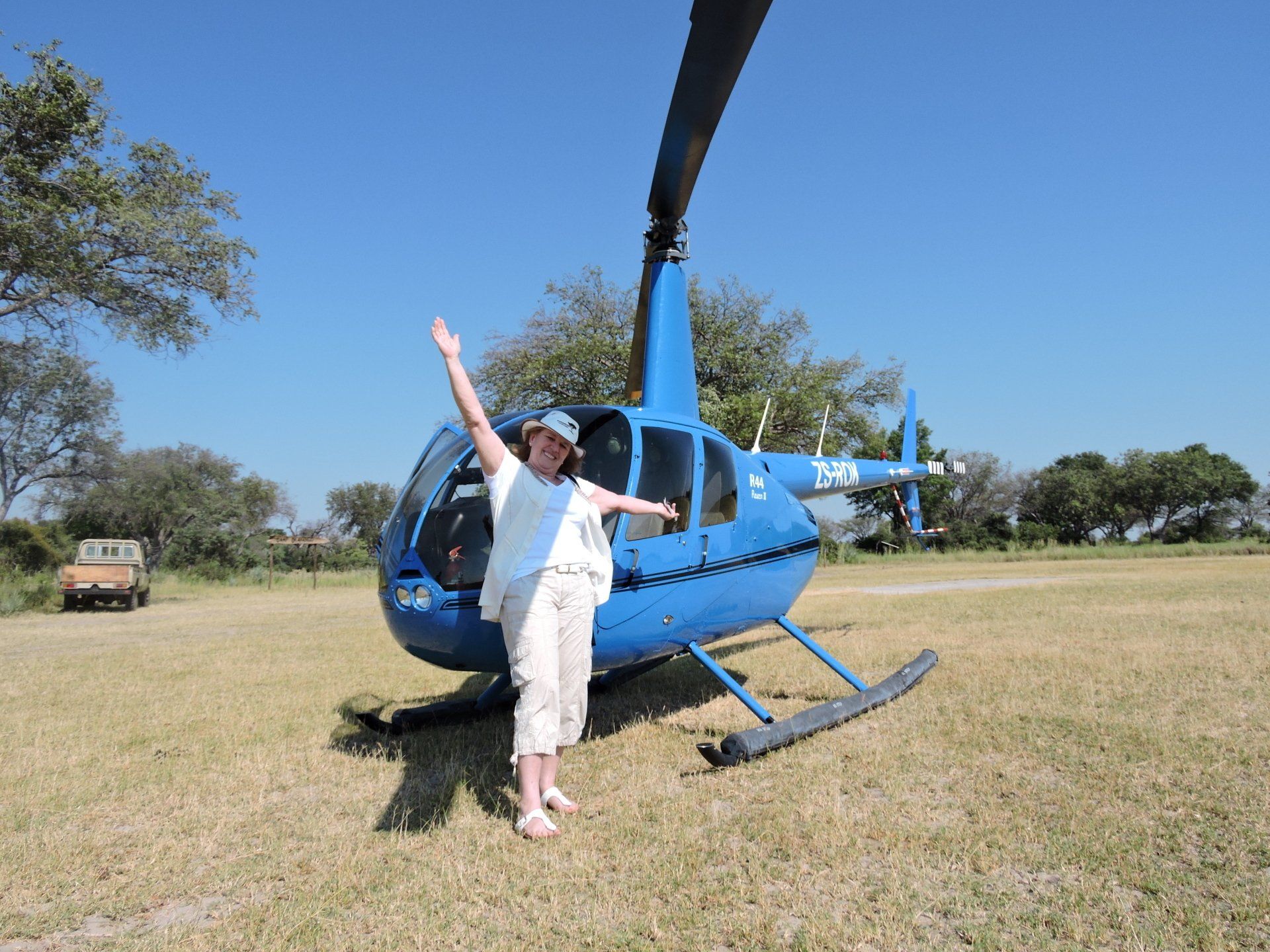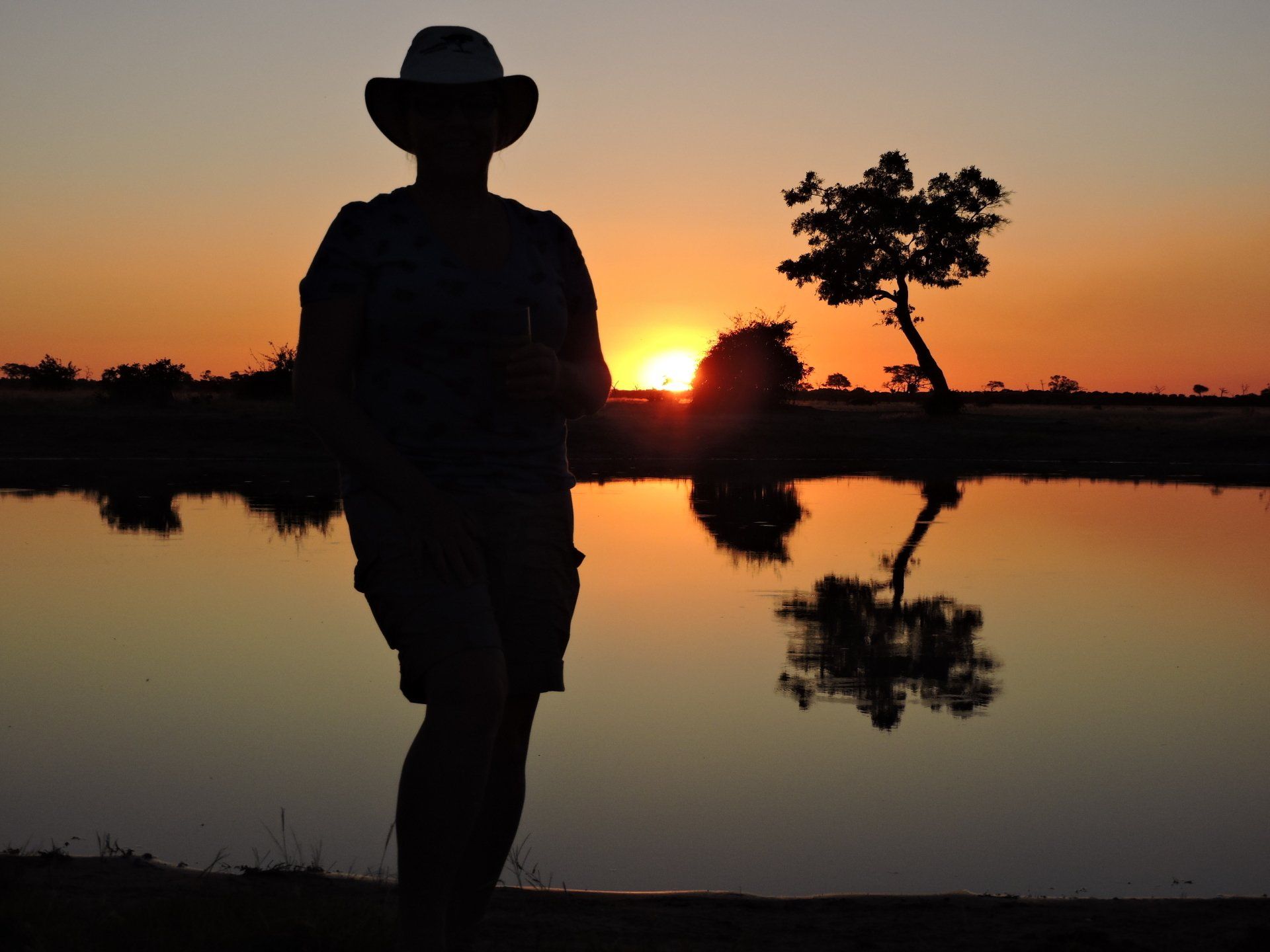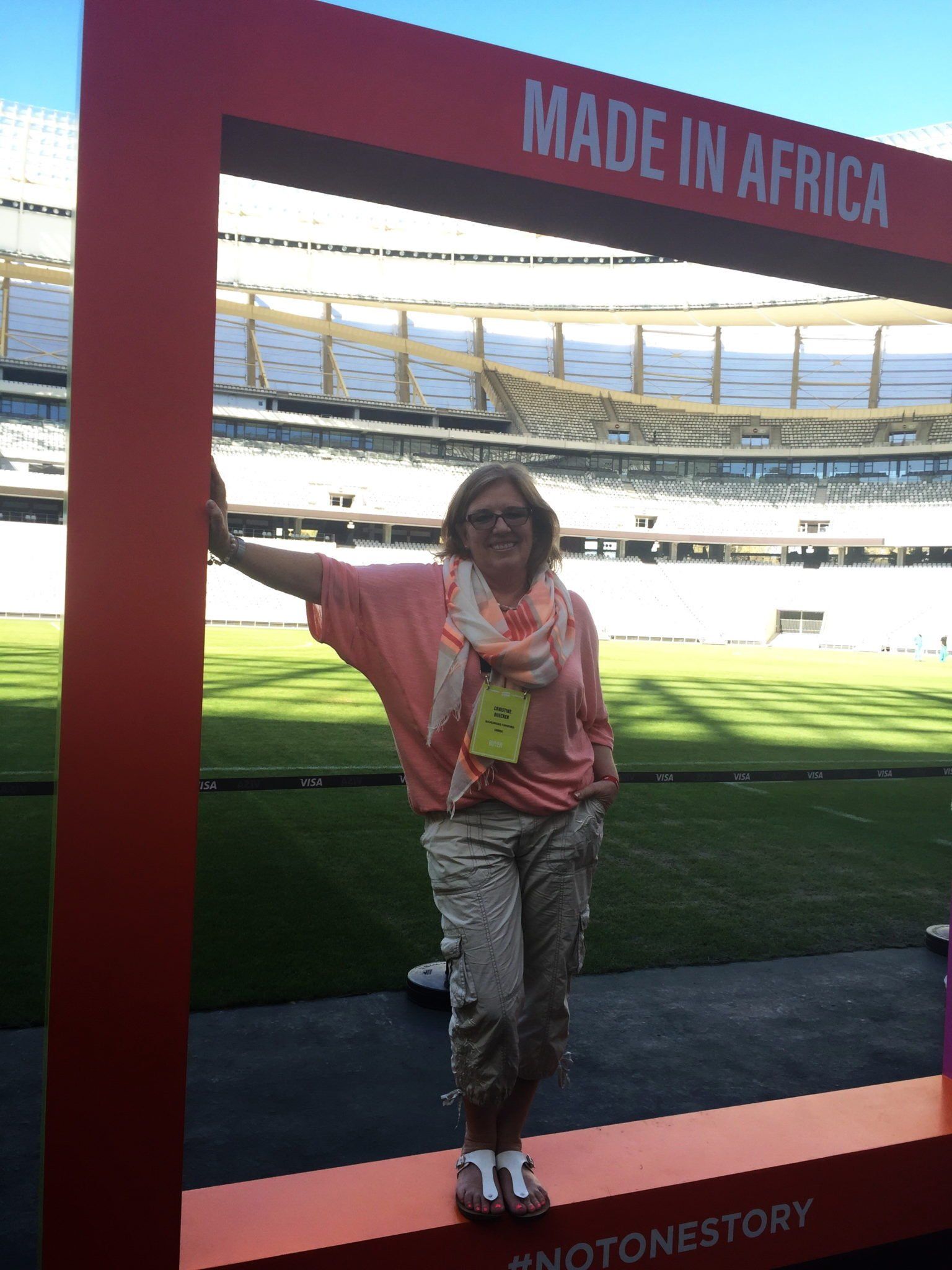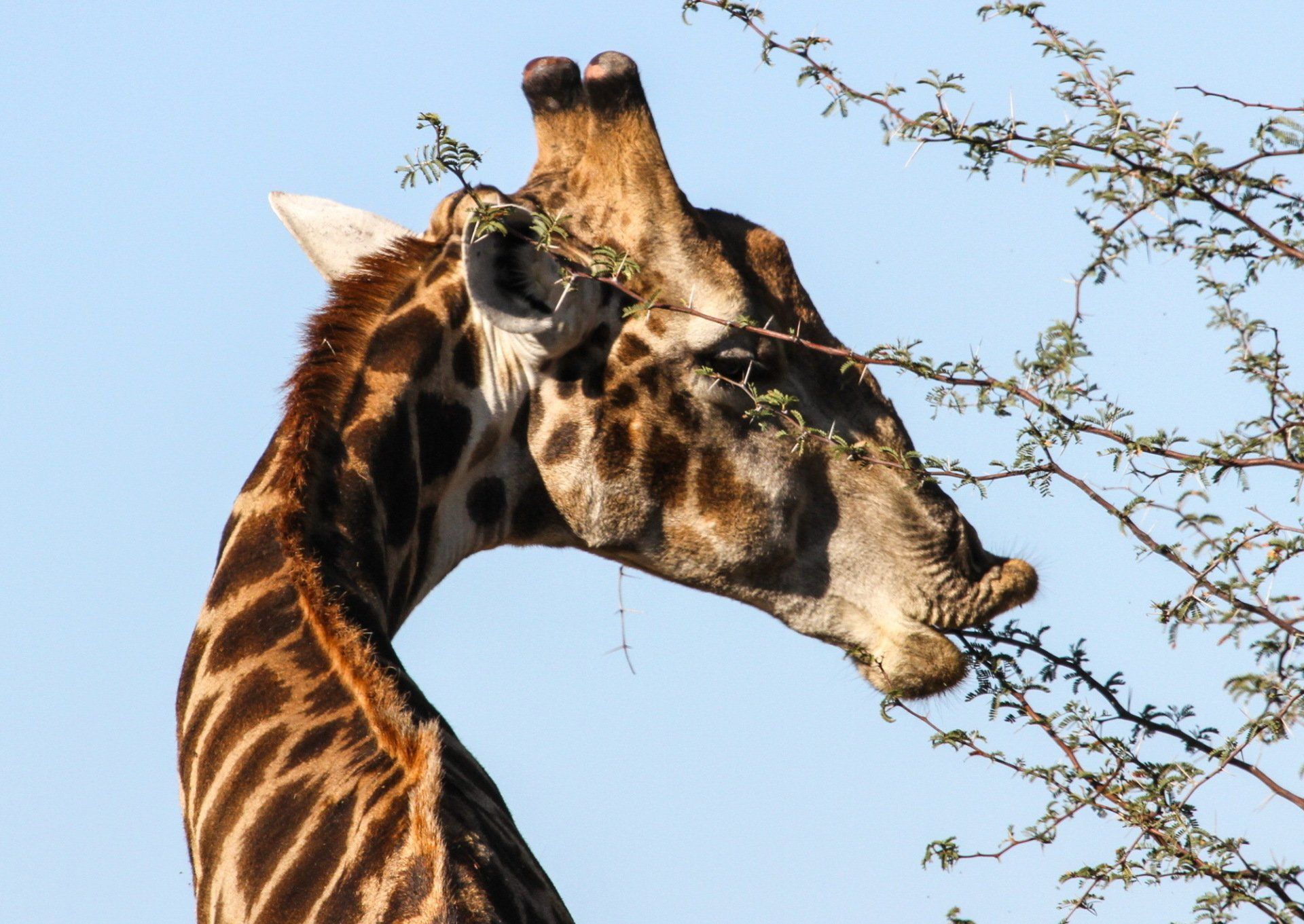ON SAFARI IN BOTSWANA
Where wildlife roams over vast distances and
the Milky Way glitters in all its glory above
Unspoiled, remote and unbelievably beautiful
Largely off-the-beaten track, Botswana is a haven for nature lovers and for wildlife, particularly elephants and big cats.
Botswana is a vast and peaceful country in Southern Africa, home to the hot and dry Kalahari Desert and the lush oasis of the Okavango Delta – reputedly one of the most beautiful places in the world and the 1000th site inscribed on the World Heritage list.
Even though Botswana is the same size as Kenya, it has just 5% of its population. That leaves a lot of undisturbed land for animals and makes for rewarding game drives and wildlife sightings, often in complete privacy.
-
About Botswana
History & Background
Botswana was formerly known as Bechuanaland and was a British colony until 1966. It was first inhabited by the San (Bushmen) and then by the Khoi-Khoi (Hottentots). The Setswana migrated southwards and slowly occupied the region from the 16th century onwards, until early in the 19th century. By mid-century missionaries arrived, including David Livingstone and Robert Moffat, and by 1885 the territory was a British protectorate.
Botswana gained its independence in 1966 and is one of Africa’s most stable democracies with a remarkable economic success story, often cited as a model for the African continent.
The country has a strong currency with one of the highest per capita incomes in Africa, maintains a neutral international political stance. It is heavily reliant on mining (especially diamonds) & tourism.
Botswana is famed for its basketry, wood carvings and Bushmen crafts. Visitors have many opportunities to purchase intriguing mementos of this exciting country.
Tourism
Wildlife is abundant in Botswana and its tourism policy is one of “low volume, high cost”. Although this policy limits the number of people able to afford trips and safaris into Botswana, it has protected the fragile environment and resources from the onslaught of mass tourism, which have taken its toll in other countries.
Geographically Botswana is relatively flat (the average elevation of about 1000 m). It is a landlocked nation a little larger than France and is bordered by South Africa in the South, Namibia to the west, Zambia to the north, and Zimbabwe to the east. Much of the country is semi-arid with the wide plains of the Kalahari covering 2/3 of the territory.
It is in the northwest of the country that the Okavango River drains inland from Angola to form the Okavango Delta – the largest inland delta in the world – which provides sustenance to a rich profusion of wildlife. The delta is extremely beautiful, big sky country with spectacular scenery across grassy plains and limpid lagoons, a complexity of channels, lagoons, floodplains and islands – the ultimate African safari destination.
-
Wildlife Regions
Chobe National Park
Established in 1968, the park covers approximately 11,700 sq kms. Chobe’s vast floodplains along the river, dry savanna and permanent swamp, dense teak woodland provides perfect eco-systems for a diverse variety of wildlife.
Watching the elephant families drink and bathe in the river is an unforgettable sight, all the more impressive when herds of buffalo, rafts of hippo and gigantic Nile crocodiles are part of the scene. Lion and spotted hyena are frequently seen on the floodplains, where red lechwe, puku, zebra, sable and roan come out to graze.
Savute
Savute – remote and wild -is situated south of the Chobe River. Unlike the vast majority of the country, Savute is not a totally flat landscape. Large outcrops of volcanic rock reach up out of the Kalahari sands, towering over the endless savannah. These hills provide habitat for a completely different array of small wildlife, birds and plants. The Savute Marsh has been the stage for many of the most dramatic wildlife documentaries in Africa. The wide-open country, good ungulate populations and particularly strong prides of lion and hyaena clans make for dramatic wildlife interaction and excellent viewing opportunities.
The area’s main feature is the mysterious Savute Channel, which flows and dries up seemingly unrelated to the rainfall. Stretching from the waterways of the Linyanti all the way to Savute Marsh, the winding waterways of Savute Channel have pumped life into the western section of Chobe National Park for many thousands of generations. But this fickle and unpredictable channel has a fascinating history of flooding and drying up independently of good rainy seasons and flood levels elsewhere – a mystery that has intrigued geologists and other researchers for many years.
Wildlife: Undoubtedly it is the interaction between lion and elephant that is the most interesting aspect of Savute. The area is inhabited by a huge pride of lions with numbers fluctuating from 20-30 members. These remarkable lions have learned over the years how to hunt these massive pachyderms that are supposedly above predation. Launching their attack under darkness and using their numbers, they manage to kill adolescent and even young adult elephant. The marsh is prime cheetah country and in the wet season it is not unusual to have the wild dog hunting here in Savute.
The area is also a famous battleground for lion and spotted hyena, whose ongoing fight for dominance has been captured in the brilliant National Geographic documentary film Eternal Enemies by Derreck and Beverly Joubert. With grazing plentiful, the area is also popular with zebra, wildebeest, buffalo, giraffe, tsessebe and kudu.
Okavango Delta
The Okavango Delta is one of the last remaining unspoiled wilderness areas of Africa. The Delta is fed by the floodwaters of Central Africa and covers an area of some 16000 sq kms and is the largest inland delta system in the world. These waters fan out into the Okavango Delta forming a wetland system of beautiful palm-fringed channels, lagoons and islands that support a wealth of fauna and flora alike.
Renowned for its abundant wildlife, the Okavango Delta sustains a huge diversity of fauna and flora, including a number of species adapted to the semi-aquatic lifestyle, such as the elegant red lechwe and shy sitatunga. Families of hippo wallow in the deeper channels and lagoons. The area supports the continent’s largest surviving concentration of elephant and buffalo, while roan and sable antelope roam the open woodlands. Lion, cheetah, leopard and African wild dog are occasionally also encountered.
One of the unique ways to explore it is by Mokoro (the traditional dugout canoe) paddled by a local guide/poler. Botswana’s Bayei people, who live around the Okavango Delta make dugout canoes from trees that have been chosen for them at birth. These days most Mokoros are made of fiberglass to preserve the trees. Your poler/guide knows the narrow waterways like the back of his hand and sometimes you’ll encounter mostly birds and a few shy antelope and then again, you may end up face to face with an elephant – a rather exciting experience. They are much larger than you can ever imagine!
Moremi Game Reserve
At the point where the life-giving waters of the Okavango Delta meet the vast plains of the Kalahari Desert, Mother Nature has created a sanctuary of Mopane forests, open grasslands, seasonal floodplains and riverine habitats, resulting in one of the most magnificent and welcoming animal environments in all of Africa.
Wildlife: Moremi is amongst the best game reserves in Africa for viewing the endangered African wild dog. It is home to a resident herd of several hundred buffalo whose range covers the territories of at least 4 prides of lion, which may often be seen flanking the ever moving herd. Breeding herds of elephant move between their browsing areas in the mopane forests and the fresh water of the Okavango. Red lechwe are one of the more unusual antelope species and commonly found here.
Moremi Game Reserve offers a broad range of safari activities on both land and water. For many guests, the highlight of their stay comes during the morning and afternoon game drives. Conducted in open 4×4 safari vehicles, the exhilarating game drives provide the chance to track wildlife in the beautiful surroundings renowned for frequent sightings of lion, leopard and cheetah. Water activities involve the exploration of water lily-ringed lagoons and surrounding Okavango Delta channels by motorboat.
The birdlife – which ranges from water birds to shy forest dwellers – is prolific and varied, and each boat trip affords guests exceptional bird-watching opportunities. Other sightings include hippos enjoying the clear, cool water, and the chance to watch big game making their way through the reeds to drink or bathe at the water’s edge.
Central Kalahari Game Reserve
The Kalahari is the largest sand basin in the world, stretching 1,560 miles (2,500km) from the northern part of South Africa, through Namibia and Angola and ending in the DRC (Congo). It may have no permanent surface water, but unlike the image of most deserts, the Kalahari is well vegetated with a wide variety of habitats including acacia trees and areas of flat grasslands that seem to stretch forever.
The CKGR is also the largest game reserve in the world and has until recently been closed to the public. Its remoteness, unforgiving climate and harsh terrain have kept it pristine and only the fully self-sufficient traveller would venture into the reserve alone. Those that do are rewarded with untamed Africa at its best.
The CKGR was originally created as a refuge for the San Bushmen – the inhabitants of the Kalahari for the past 30,000 years. They lived in nomadic hunter-gatherer family groups only taking what they needed to survive – which is an art form in the Kalahari. Their simple lifestyle became anathema to the sophisticated Europeans who colonized Southern Africa and the Bushmen found themselves the hunted rather than the hunter.
Bushmen survival became an issue in 1961 when Botswana was still a British Protectorate, and the CKGR was formed as their homeland. Most have now intermixed with other tribes such as the Bakgalagadi and live in villages at the southern end of this reserve. Their traditional lifestyle is all but gone but some bush survival knowledge is still passed down from generation to generation.
Makgadikgadi Pans
The lesser-known Makgadikgadi Pans National Park is situated roughly between Maun and Nata in Botswana. The shimmering saltpans of Makgadikgadi are the size of Switzerland and most of the time appears as glaring, white, endless plain. When the rain comes a dramatic change takes place as the pans come to life with frantically feeding water birds and great herds of game. The best time to visit this area to coincide with the Zabra migration is from December to March or in the dry season from April to October when the pans are dry.
The park contains four main vegetation types: riverine woodland, scrubland, pure grassland and saltpans. The pans support palm groves and peculiar looking Baobab trees whose branches look more like roots, giving rise to the name ‘upside down tree’. These are interspersed with short spiky yellow grass found on rises between the pans, known as ‘prickly salt grass’. This is extremely saline resistant to the extent that salt crystals can sometimes be seen on the leaves. The interior of the reserve comprises scrub and grassland with a few ‘islands’ of Real Fan Palms and Camel thorn acacia. From April to November game such as springbok, gemsbok, wildebeest and zebra move slowly from the pans area in the south east of the park, to the Boteti River on the western side. During this migration animals accumulate in their thousands. The heavily wooded areas beside the river also contain shy antelopes like duiker and bushbuck.
Nxai Pan National Park
Located on the northern fringe of the Makgadikgadi basin, Nxai Pan National Park includes an ancient lake bed that was once part of the vast Lake Makgadikgadi. At roughly 2 580 km² this incredible destination offers stark contrasts between its dry and wet seasons. During the dry season, visitors will be treated to sightings of wildebeest, springbok, impala, gemsbok, hartebeest, giraffe, lion, cheetah, wild dog, brown hyena, bat-eared fox, and occasionally elephant and buffalo. In the rainy season, it is home to the seasonal Zebra Migration, where vast herds (accompanied by a slew of predators) can be seen on open grasslands, amidst the mottled shade of acacia trees.
-
Country Info | Climate | Safari FAQ's
Republic of Botswana:
Botswana is a landlocked country that provides a natural habitat for a huge variety of African wildlife.
• Area: 600 370 km² of which nearly 17% is protected wildlife area. The country has one of the lowest population densities in Africa with an average of less than three people per km²
• Capital: Gabarone
• Currency: Pula
• People: Botswana 95%, Kalanga, Basarwa, Kgalagadi 4%, European 1%
• Official language: Setswana is the national language and English is the business language
• Time: GMT +2
Climate:
The climate is semi-arid with 85% of the country covered by Kalahari sands. Temperatures soar in the summer months (November to March) reaching highs between 30°C and 40°C. Erratic rain-showers are common in the summer.
In winter months (June to August) warm days are followed by cold nights. Daytime temperatures average around 23°C with night-time lows averaging 5°C.
BEST TIMES TO VISIT BOTSWANA
Having recently been named Africa’s Best Safari Destination, Botswana offers spectacular sightings of wildlife in their natural habitat. Whether you’re looking to spot animals on a game drive or by mokoro (dug out canoe) around the shallow waters of the Okavango Delta, these are the best times to plan your trip according to the seasons.
June to October is the dry season and offers unmatched game viewing, because it attracts thousands of animals including herds of elephants, buffalo and antelope alongside predators to the water-rich areas of the Okavango Delta and the Chobe and Linyanti Rivers.
November to March - these are the country’s hottest and wettest months. The landscape transforms as flowers begin to bloom and the land that was once brown and dry is covered in lush greenery. If you’re a bird lover, plan your trip around the green season.
The magic months are April and May, when the heat and showers of the summer should be long past, and the African fall begins to make itself known. The wildlife viewing may not be quite as strong as during the unbeatable dry season because the grasses are long and water is widely available to wildlife, but it’s still better than many other safari areas during their strongest season. Plus, it’s a photographer’s delight because the skies are crisp, the bush is full of flowers and baby animals, and the birding is phenomenal.
Safari FAQ’s
-
6 Interesting Facts about Botswana
1. It’s home to the world's largest inland delta, the Okavango Delta, which is formed by seasonal flooding of the Okavango River. This unique ecosystem is a safari paradise where you can find about 170 mammal species, including lions, cheetahs, hippos, crocodiles and many bird and reptile species.
2. Botswana encompasses the 900,000 km² Kalahari Desert, home to many antelope species, big cats including the black-maned lion and incredible birdlife. Here you can meet the San people, hunter-gatherers who have survived in this semi-arid region for 20,000 years and who still hunt with bows and poison arrows.
3. Although Botswana is landlocked, you can enjoy boat cruises and fishing on the Chobe River and Mokoro (dug-out-canoe) rides in the Okavango Delta.
4. Botswana is a real-life wonderland for elephant lovers! The country has the world's largest population of elephants which are protected by strict anti-poaching laws, meaning you can see them in all their majestic glory.
5. It’s home to a number of different ethnic groups, each with their own unique culture and traditions. Visitors can experience the rich culture and traditions of these groups through traditional village visits and cultural performances.
6. Botswana is known for its stability and democracy, which is great for travellers because it allows for the conservation and protection of the country's wildlife and natural resources.
The Okavango
To get a taste of this incredibly beautiful wilderness, take a look at the National Geographic documentary, which chronicles a team of modern-day explorers, lead by conservation biologist Steve Boyes on an epic four-month, 1500-mile expedition across three countries to save the Okavango river system.
(Trailer, 2:16 mins)
Splendours of Africa

This luxurious fly-in safari takes you on a spectacular journey through the most remote wilderness areas in Africa for outstanding wildlife viewing in a variety of eco-systems.
Our rejuvenating safari includes time to experience and explore the world-famous Victoria Falls, the diverse and wildlife-rich Chobe National Park and Savute river systems, the blue-green wetlands of the Okavango Delta, the vast floodplains of the Moremi Wildlife Reserve, culminating in the stark and remote beauty of the Kalahari Desert.
For those who savour the finest wilderness sightings in the solitude of Botswana's wilderness, this safari is the perfect choice.
-
Safari Highlights
• Stay at authentic boutique lodges and Under Canvas safari camps
• Move between camps by light aircraft, affording a birds-eye view of the stunning scenery
• Savour game drives in open-sided 4×4 safari vehicles with knowledgeable safari guides
• Enjoy guided game walks, night game drives, mokoro and boat rides
This safari is combinable with our Desert Horseback Safari and can be customized to suit your desired length of stay.
Contact Africa Travel Specialist, Christine Boecker to tailor-make this safari for you
(TTFit)
-
Itinerary Overview
Day 1 Victoria Falls, Zimbabwe
On arrival at the airport you will be met and transferred to the luxurious Safari Club – a 20-room boutique lodge set high on a natural plateau bordering the Zambezi National Park, and just four km’s from the thundering Victoria Falls.
With uninterrupted views of spectacular African sunsets and year round game at its own waterhole, this lodge offers the most discerning traveller a taste of Africa at its best.
This afternoon celebrate the start of your epic journey with a sunset cruise on the magnificent upper Zambezi River.
Day 2 Victoria Falls
Discover one of the 7 natural wonders of the world on a private tour of Victoria Falls.
Enjoy some leisure time as you explore the charming dusty, rusty little town of Victoria Falls.
This evening it’s dinner and a drum show at the Boma – with exuberant cultural songs, dances and an extraordinary traditional meal!
Days 3 - 5 Chobe National Park, Botswana
Take a private road transfer to Chobe National Park and savour 3 nights at a deluxe safari lodge. Situated above the Chobe River, this luxurious 15 cottage lodge has a full spa and offers unparalleled panoramic views across the islands and floodplains. Each cottage has a free-standing bath, indoor and outdoor shower, air-conditioning and a terrace with a hammock.
During your 3 days on safari in Chobe National Park you can get close-up to wildlife from various vantage points, whether by boat, or by open 4x4 safari vehicle. Animal viewing is prolific with large herds of elephants, big cats, antelope, hippo, crocodile and a mind-boggling array of water birds.
Days 6 - 8 Savute Marsh
Transfer by light aircraft to a luxurious camp located on the banks of the Savute channel, your home for the next 3 nights.
Housed on raised wooden platforms, the lodge’s 12 luxurious thatched suites feature sliding glass doors that bring the outside in, allowing you to observe the abundant wildlife from the comfort of your large private deck—furnished with easy chairs and a hammock—ideal for admiring the beautiful plains, or for enjoying a romantic dinner in complete privacy.
The camp has its own traditional boma, where your can relax in the evening and swap safari experiences while marveling at the stars in the vast African night sky.
Enjoy the next 3 days on safari in the Savute area, renowned for its population of bull elephants and for the unique interaction of the resident predator species.
Days 9 - 11 Moremi Game Reserve
Morning transfer by light aircraft to your luxury safari lodge nestled on the edge of a forest overlooking the vast floodplains of the Moremi Game Reserve.
For a more secluded, romantic experience this lodge offers a private suite, which is tucked away from the main rooms. The large deck includes a heated splash pool with full views of the reserve. Inside you’ll find a netted four-poster bed, a stocked mini bar, discreet air conditioning and an elegant bathroom, complete with double showers and copper-framed Victorian bath, bringing you closer to nature.
Your 3-night stay includes day and night game drives, walking safaris, birdwatching and a visit to the San Bushman village.
Conducted in open 4×4 safari vehicles, the exhilarating game drives provide the chance to track wildlife in the beautiful surroundings of Moremi Game Reserve, a protected area renowned for frequent sightings of lion, leopard and cheetah. African Wild Dog sightings are also regularly reported, an endangered species whose numbers are rapidly dwindling in other areas.
Days 12 & 13 Okavango Delta
Catch a birds-eye view of the iconic Okavango Delta as you take a light aircraft transfer to a remote island camp in the middle of the delta - your home for the next 2 nights.
Situated among a web of waterways and lush vegetation, this ultimate luxury safari paradise overlooks a lagoon that attracts a breathtaking variety of big game and exotic birds.
All 11 luxury rooms are housed on raised wooden platforms and shaded by a traditional African thatch roof. Private decks command inspiring views and are complete with easy chairs and a hammock.
For a more intimate safari experience opt for the exclusive private suite. A secluded deck features a generous splash pool, and your open-air bathroom is protected by the tree canopy.
Explore the Okavango Delta by Mokoro (dug-out canoe), set out on a game drive or roam on foot. All game-viewing activities are conducted by experienced guides. Seasonal fishing and birdwatching are also available.
Helicopter flights over the Delta are one of life’s big adventures and the animals are unperturbed by our aircraft. Surprisingly, you may hover just a few feet over great herds of zebra as they continue to graze, completely unconcerned. A Helicopter Safari offers access to remote, inaccessible lakes and islands that can only be seen from the air.
Even more exciting, you may touch down on an island far away from human habitation and stand in a spot that, for thousands of years, has been cut off from the world beyond. A speed boat may appear bearing coffee or a celebratory glass of sparkling wine. Sip at leisure as you gaze on lush, riverine scenery in one of the world’s last untouched wildernesses.
Days 14 & 15 Central Kalahari Game Reserve
Fly by light aircraft to our Desert Camp, offering truly incredible views from the ridge of an ancient sand dune, an unusual experience in a land as flat as Botswana.
Overlooking the famous Tau Pan with its stark beauty and remoteness, this camp accommodates up to eighteen guests in specially designed thatched suites on raised decks. This, the first safari camp to be built in the Central Kalahari Game Reserve (CKGR), is a model of environmental sensitivity, having been constructed with the delicate ecology in mind. Using only solar power for the generation of electricity, heating of water and pumping water from deep under the Kalahari sands, the wastewater is treated in a state-of-the-art treatment plant and the fully treated water is returned to the sands from whence it came.
Activities include game drives, day trips to Deception Valley, Sunday, Piper and Passage Pans, star gazing, bush brunches on the Tau Pan, and nature walks with Bushman trackers.
Day 16 Depart Africa
Spend your last morning enjoying the uninterrupted views of the spectacular African scenery before you are transferred by light aircraft to Maun airport in time for onward flights.
This safari is combinable with our Desert Horseback Safari and can be customized to suit your desired length of stay.
Contact Africa Travel Specialist, Christine Boecker to tailor-make this safari for you
(TTFit)
Legacy Safari

Relive the golden age of safaris as you step into the shoes of the early adventurers and discover Africa as it was meant to be seen.
Experience extraordinary wildlife, beautiful landscapes and untouched water courses while contributing directly to the conservation of big cats and supporting local communities.
By staying at these camps you support the environment as well as a community empowerment project.
By saving a few pounds of space in your suitcase and
Packing for a Purpose, you can bring supplies for an education program and a women’s group and make a priceless impact on the lives of local children and families.
-
Itinerary Overview
Days 1 – 4 Okavango Delta
Fly into Duba Explorers Camp, designed by National Geographic filmmakers, conservationists and explorers, Dereck and Beverly Joubert, evoking the classic safari style of the 1920’s. A wildlife connoisseur’s delight, the camp embodies the spirit of exploration and is located on an island in the northern Okavango Delta, surrounded by thousands of animals.
The camp consists of five airy, stylishly furnished canvas tents on raised decks with a private verandah and en-suite facilities, offering you the ultimate opportunity for private wildlife sightings.
Discover the Ngoga River system by boat or traditional canoes (mokoro), meandering through water channels created by hippos and elephant. The mokoro allows you to glide silently through this unique eco-system and experience the undisturbed water world around you.
Birding is unsurpassed, with spectacular species like the malachite kingfisher zipping past you in a burst of colour.
Vehicle safaris in this paradise allow for exciting encounters with predators such as lion, leopard and African wild dogs (painted wolf), resident to the area. Explore the islands, wetlands and plains on guided walks following the tracks and interpreting the signs of the wild. The year-round healthy herbivore population include elephant, buffalo and lechwe. You might even be lucky enough to get a glimpse of a rare sitatunga.
Days 4 - 7 Selinda Spillway
Flight by light aircraft to Selinda Explorers Camp, located on a remote stretch of the Selinda Spillway in northern Botswana.
Four traditional canvas tents ‘wow’ with the grandeur of the expedition-style décor – campaign furniture and vintage travelling trunks, lending an authentic atmosphere to this camp as you tread in the footsteps of the explorers Livingstone and Selous.
Wildlife viewing focuses mainly on guided walks and mokoro trips, but also open vehicle game drives in an area which is home to huge herds of elephant and buffalo. Lion, leopard, cheetah and wild dog hunt these parts regularly. Good densities of giraffe and antelope – even roan and sable – and the recently spotted eland are possible sightings.
There is phenomenal bird life along the Spillway’s banks for those looking for some ‘lifers’.
Savour 3 nights at each camp, including all meals prepared by an executive chef, paired with hand-picked wine list; alcoholic and non-alcoholic beverages; air transfers and laundry services.
Day 8 Depart
As you bid farewell to this remote corner of Botswana you will not only leave with a lifetime of memories, but also knowing that your visit has had a positive impact on the local people and their environment.
This safari can be customized to suit your desired length of stay.
Contact Africa Travel Specialist, Christine Boecker to book this Legacy Safari
(GP)
-
Leaving a Legacy
By staying at Duba Explorers Camps you support a community empowerment project on land leased from five local communities, who in turn receive all of the lease revenue. Currently 80% of the staff come from these communities.
Selinda Explorers Camp has been hand-built to reduce impact on the environment. Run 100% on solar power, it has a grey water treatment plant, uses bore-hole water for drinking and focuses on activities which get back to nature and away from the need for engines – namely more walking and canoeing.
Contact Africa Travel Specialist, Christine Boecker to book this Legacy Safari
(GP)
Mobile Tented Safari
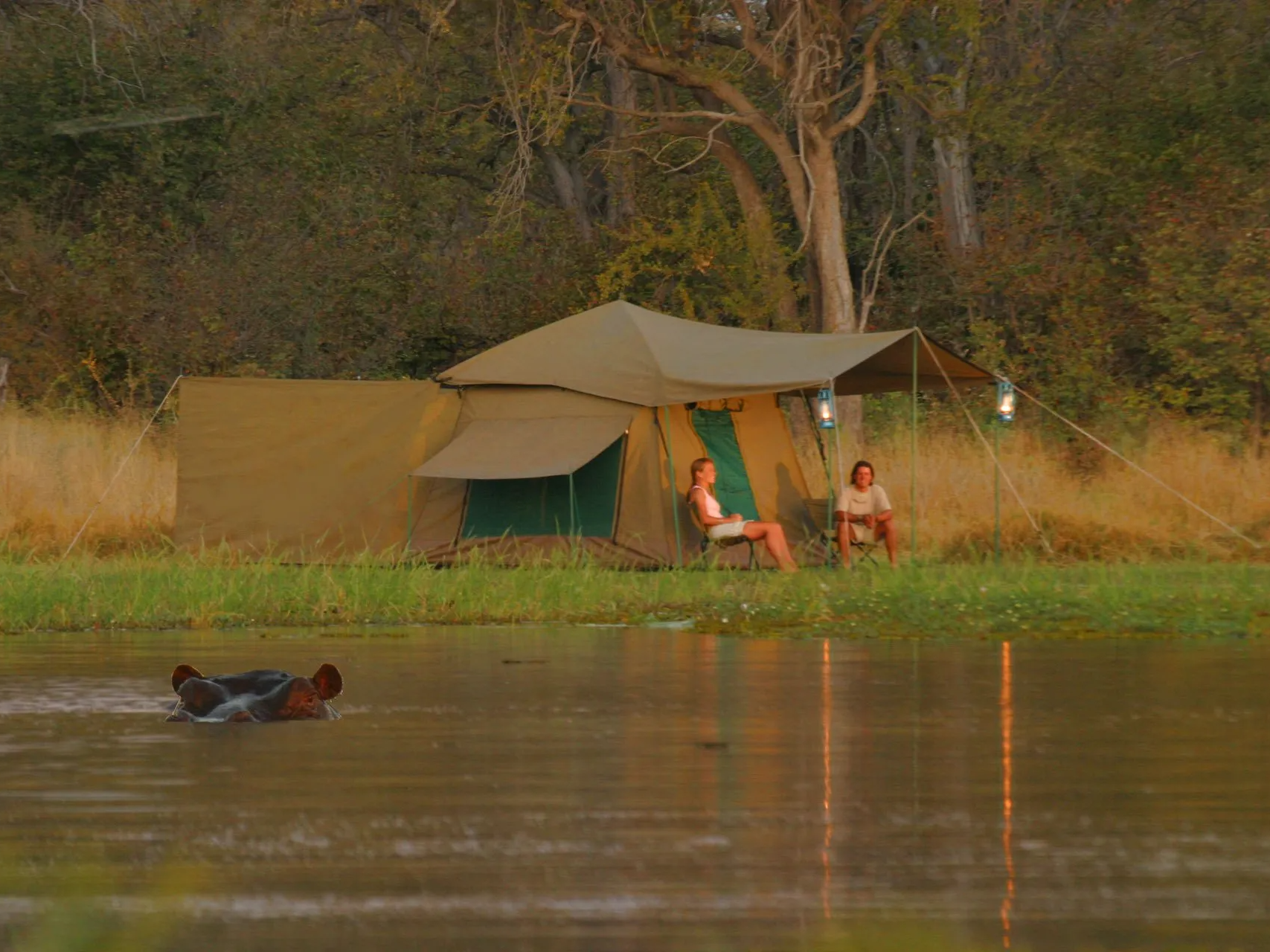
Our fully serviced Mobile Tented Safaris are an authentic way to experience true wild Africa in traditional safari style!
After a day of exciting game viewing in spacious and comfortable open 4×4 safari vehicles, you’ll arrive at your mobile tented camp, which has been set up for you in an exclusive wilderness site. A 3-course dinner awaits, which is devoured by hungry explorers sitting around a communal table in the open-sided mess tent.
Listen to the sounds of the African night, revel in campfire stories under the vast African starlit sky before retiring for the night to your comfortable walk-in tent.
-
Safari Highlights
• The Moremi Game Reserve
• Exploring the fringes of the Okavango Delta by mokoro
• The freedom of the Khwai Concession Area
• Chobe National Park (Savute & Chobe River front)
• Boat cruise on the Chobe River
• Flight over the Okavango Delta
• Accommodation is in comfortable walk-in tents. Facilities include beds, linens, duvets and en-suite bathroom with chemical WC and bucket shower.
Contact Africa Travel Specialist, Christine Boecker to join this authentic African Safari
(LT)
-
Itinerary Overview
Days 1 – 3 Moremi Game Reserve
Our first three nights are spent in the Xakanaxa region where we explore the surrounding wilderness on morning and afternoon game drive excursions.
Days 4 – 6 Khwai River Community
We spend the following two nights camping in the community area, exploring the Khwai floodplains on day and night game drives, on guided walks and by mokoro (dug-out canoe)
Days 7 – 10 Savute Marsh
We head further north where we spend the following three nights camping in an exclusive wilderness campsite in the Savute region, exploring the semi-arid landscape on game drives.
Day 10 Chobe River
On our final day we travel to the Chobe River, enjoying an afternoon boat cruise to end our safari.
Includes
• Spacious and comfortable walk-in tented accommodation with a private bathroom
• Services of a professional guide, safari chef and camp assistants
• Game drives and local transfers in customized safari vehicles
• Exclusive camping in private campsites within the national parks and reserves
• All meals and drinks (mineral water, soft drinks, beer, wine and G&T)
• All entrance and camping fees
Contact Africa Travel Specialist, Christine Boecker to join this authentic African Safari
(LT)
-
For Photographers & Birders
We have special departures for birders and keen shutter-bugs: imagine travelling in the company of a professional photographer with many years of experience photographing in Botswana, and who knows his birds too. Add to the picture a safari guide, who also understands the importance of lighting, and a specially adapted safari vehicle with window seats for everyone and unobstructed views of the wildlife - the perfect focus for your safari.
Whether you are an eager beginner with your first DSLR or an experienced photographer looking to take your images to the next level, this small-group trip ensures that you’ll have many opportunities for that perfect shot. Getting you to the right place at the right time is what sets this safari apart from many others.
Contact Africa Travel Specialist, Christine Boecker to join this authentic African Safari
(LT)
BeWILDered about Africa? We specialize!
Visit About African Safaris to learn what you can experience on your safari. We debunk common safari myths, elaborate on safari styles, describe the Big Five and address frequently asked questions. More >>
TESTIMONIALS

“Thanks for your help in planning our trip of a lifetime. Botswana was our favourite! I also enjoyed the Africa Journal you gave us to record all the animals we saw.”
Jennifer, Squamish BC

“It's normal to have some fears if this is your first time to Africa, but you will be better taken care of than you have probably ever been in your life. Christine is very knowledgeable and knows her way around Africa. Thanks, Christine for such a successful safari!!”
Cathy, Vancouver BC

“With very short notice, Christine Boecker planned a fabulous trip to Botswana for us. Trip was fantastic- and without a faux. All details were letter-perfect and beyond expectations. Couldn't recommend Christine more highly. Bravo!!!!”
Derek, Toronto ON
Memories from Christine's Botswana Safaris:
TRΛVELBOECKER ΛDVENTURES Insider’s Reports:

GET IN TOUCH
TRΛVELBOECKER TΛILOR-MΛDE
Unique Safaris designed to meet your Personal Vision
OVERVIEW
CONTACT
LOCATION
Vancouver BC
Canada
Div. of PTM Ltd. | BC Reg #2806
© TRΛVELBOECKER ΛDVENTURES 2002 - 2022





